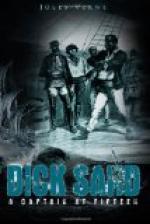David Livingstone left Loanda, September 24th of the same year. He skirted the right bank of that Coanza that had been so fatal to Dick Sand and his party, arrived at the confluence of the Lombe, crossing numerous caravans of slaves, passed by Cassange again, left it on the 20th of February, crossed the Coango, and reached the Zambezi at Kawawa. On the 8th of June he discovered Lake Dilolo again, saw Shinte again, descended the Zambezi, and reentered Linyanti, which he left on the 3d of November, 1855.
This second part of the journey, which would lead the doctor toward the eastern coast, would enable him to finish completely this crossing of Africa from the west to the east.
After having visited the famous Victoria Falls, the “thundering foam,” David Livingstone abandoned the Zambezi to take a northeastern direction. The passage across the territory of the Batokas (natives who were besotted by the inhalation of hemp), the visit to Semalembone (the powerful chief of the region), the crossing of the Kafone, the finding of the Zambezi again, the visit to King Mbourouma, the sight of the ruins of Zambo (an ancient Portuguese city), the encounter with the Chief Mpende on the 17th of January, 1856 (then at war with the Portuguese), the final arrival at Tete, on the border of the Zambezi, on the 2d of March—such were the principal halting-places of this tour.
The 22d of April Livingstone left that station, formerly a rich one, descended as far as the delta of the river, and arrived at Quilimane, at its mouth, on the 20th of May, four years after leaving the Cape. On the 12th of July he embarked for Maurice, and on the 22d of December he was returning to England, after sixteen years’ absence.
The prize of the Geographical Society of Paris, the grand medal of the London Geographical Society, and brilliant receptions greeted the illustrious traveler. Another would, perhaps, have thought that repose was well earned. The doctor did not think so, and departed on the 1st of March, 1858, accompanied by his brother Charles, Captain Bedinfield, the Drs. Kirk and Meller, and by Messrs. Thornton and Baines. He arrived in May on the coast of Mozambique, having for an object the exploration of the basin of the Zambezi.
All would not return from this voyage. A little steamer, the “My Robert,” enabled the explorers to ascend the great river by the Rongone. They arrived at Tete, September the 8th; thence reconnoissance of the lower course of the Zambezi and of the Chire, its left branch, in January, 1859; visit to Lake Chirona in April; exploration of the Manganjas’ territory; discovery of Lake Nyassa on September 10th; return to the Victoria Falls, August 9th, 1860; arrival of Bishop Mackensie and his missionaries at the mouth of the Zambezi, January 31st, 1861; the exploration of the Rovouma, on the “Pioneer,” in March; the return to Lake Nyassa in September, 1861, and residence there till the end of October; January 30th, 1862, arrival of Mrs. Livingstone and a second steamer, the “Lady Nyassa:” such were the events that marked the first years of this new expedition. At this time, Bishop Mackensie and one of his missionaries had already succumbed to the unhealthfulness of the climate, and on the 27th of April, Mrs. Livingstone died in her husband’s arms.




